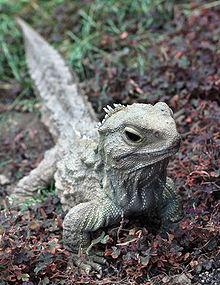| Rhynchocephalians | |
|---|---|

| |
| The tuatara (Sphenodon punctatus), the only living rhynchocephalian | |

| |
| Fossil of Vadasaurus, a rhynchocephalian from the Late Jurassic of Germany | |
| Scientific classification | |
| Domain: | Eukaryota |
| Kingdom: | Animalia |
| Phylum: | Chordata |
| Class: | Reptilia |
| Superorder: | Lepidosauria |
| Order: | Rhynchocephalia Günther 1867 |
| Type species | |
| Sphenodon punctatus Gray, 1842
| |
| Subgroups | |
Rhynchocephalia (/ˌrɪŋkoʊsɪˈfeɪliə/; lit. 'beak-heads') is an order of lizard-like reptiles that includes only one living species, the tuatara (Sphenodon punctatus) of New Zealand. Despite its current lack of diversity, during the Mesozoic rhynchocephalians were a speciose group with high morphological and ecological diversity. The oldest record of the group is dated to the Middle Triassic around 238 to 240 million years ago, and they had achieved global distribution by the Early Jurassic.[1] Most rhynchocephalians belong to the group Sphenodontia ('wedge-teeth'). Their closest living relatives are lizards and snakes in the order Squamata, with the two orders being grouped together in the superorder Lepidosauria.
Once representing the world's dominant group of small reptiles, many of the niches occupied by lizards today were held by rhynchocephalians during the Triassic and Jurassic. Rhynchocephalians underwent a great decline during the Cretaceous, and they had disappeared almost entirely by the beginning of the Cenozoic. While the modern tuatara is primarily insectivorous and carnivorous, the diversity of the group also included the herbivorous eilenodontines, and there were other rhynchocephalians with specialised ecologies like the durophagous sapheosaurs. There were even successful groups of aquatic sphenodontians, such as the pleurosaurs.[2]
- ^ Jones ME, Anderson CL, Hipsley CA, Müller J, Evans SE, Schoch RR (September 2013). "Integration of molecules and new fossils supports a Triassic origin for Lepidosauria (lizards, snakes, and tuatara)". BMC Evolutionary Biology. 13 (1): 208. Bibcode:2013BMCEE..13..208J. doi:10.1186/1471-2148-13-208. PMC 4016551. PMID 24063680.
- ^ Reynoso VH (2000). "An unusual aquatic sphenodontian (Reptilia: Diapsida) from the Tlayua Formation (Albian), central Mexico". Journal of Paleontology. 74 (1): 133–148. Bibcode:2000JPal...74..133R. doi:10.1017/s0022336000031310. S2CID 232346834.